While most community colleges are planning for virtual or remote learning this fall, on-campus health and safety needs persist, demanding attention and a greater role for technology solutions.

As the COVID-19 pandemic upends higher education in 2020, institutions are relying on digital alternatives to missions, activities, and operations. Challenges abound. EDUCAUSE is helping institutional leaders, IT professionals, and other staff address their pressing challenges by sharing existing data and gathering new data from the higher education community. This report is based on an EDUCAUSE QuickPoll. QuickPolls enable us to rapidly gather, analyze, and share input from our community about specific emerging topics.1
The Challenge
Previous EDUCAUSE research has highlighted the unique technology needs of community college students, particularly those students navigating their courses in addition to full-time responsibilities at home (e.g., dependents, careers).2 While continuing to serve these existing students, some community colleges this fall may experience larger enrollments of students who are searching for affordable and convenient learning options as COVID-19 disrupts traditional models of higher education elsewhere.3 With these unique opportunities for increasing enrollment, and the unique needs of the students they currently serve, how are community college technology leaders helping to position their institutions for success and safety this fall term? What technologies and solutions are these institutions deploying, and where are they devoting more or less of their attention in their planning and preparation?4
The Bottom Line
Though the vast majority of community colleges are offering most or all of their courses virtually or remotely this fall, health and safety needs remain for those essential staff and faculty required to work on campus, as well as for those students taking courses with in-person components. Though many community colleges are implementing solutions and strategies for ensuring a safe fall term, most are doing so through "manual" and "homegrown" means (e.g., sign-in sheets, staffed checkpoints, homegrown technology solutions). This may suggest an opportunity across community colleges to more effectively leverage existing technologies, as well as explore vendored solutions, for navigating institutional challenges and needs.
The Data: On Campus for Fall?
Most courses are being held virtually or remotely this fall. The general shift to online course delivery for higher education this year5 holds true for community colleges as well: more than half of our survey respondents indicated their institution is planning virtual or remote education for all or most of their courses this fall, and nearly all of the remaining respondents said their institution is planning for hybrid in-person and virtual/remote education options (see figure 1). Only one respondent reported that all the institution's courses would be in-person this fall.

Many staff and faculty remain on campus. As community college courses move to virtual or remote modes of delivery, most institutions will still maintain some form of brick-and-mortar presence through their staff and/or faculty. Indeed, more than three-quarters of respondents reported that while not all staff and faculty are currently working on campus, their "essential" staff and faculty are. Nearly one-sixth of respondents indicated that all staff and faculty would be working remotely until a later date; another 14% indicated that working remotely or on campus had been left up to staff and faculty to choose (see figure 2).
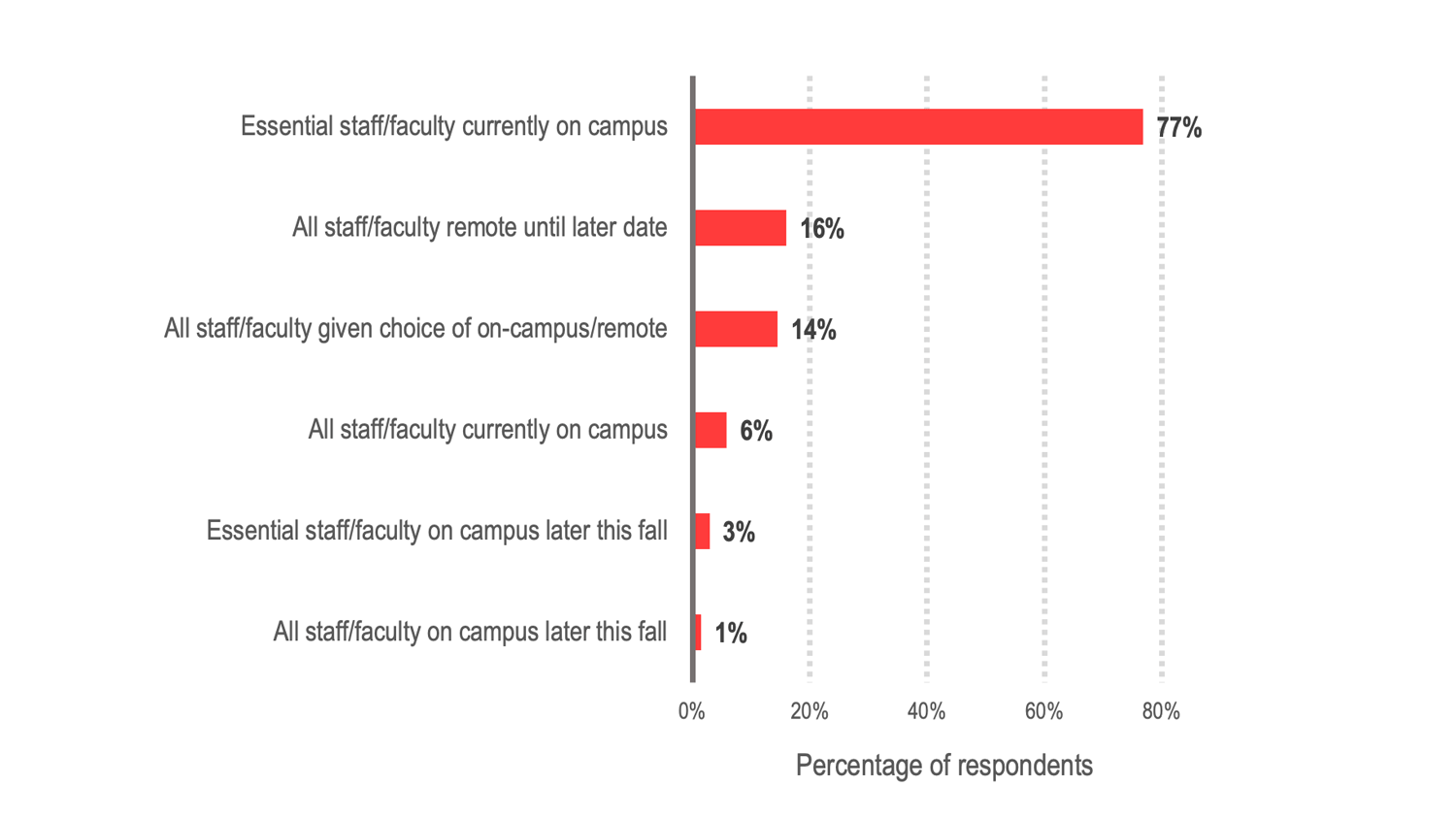
The Data: Contact Tracing
Most contact tracing solutions in use are "homegrown." A majority of respondents indicated that their institution would not be using contact tracing technology for the fall term (see figure 3), consistent with earlier EDUCAUSE QuickPoll findings about planned levels of contact tracing among all types of institutions.6 For those institutions planning to use contact tracing technology—whether only for students, only for staff and faculty, or for everyone—the technology solutions they're deploying in these efforts are most commonly "homegrown," with a handful of respondents reporting the use of Ready Education, Campus Clear, and class schedules for these purposes.
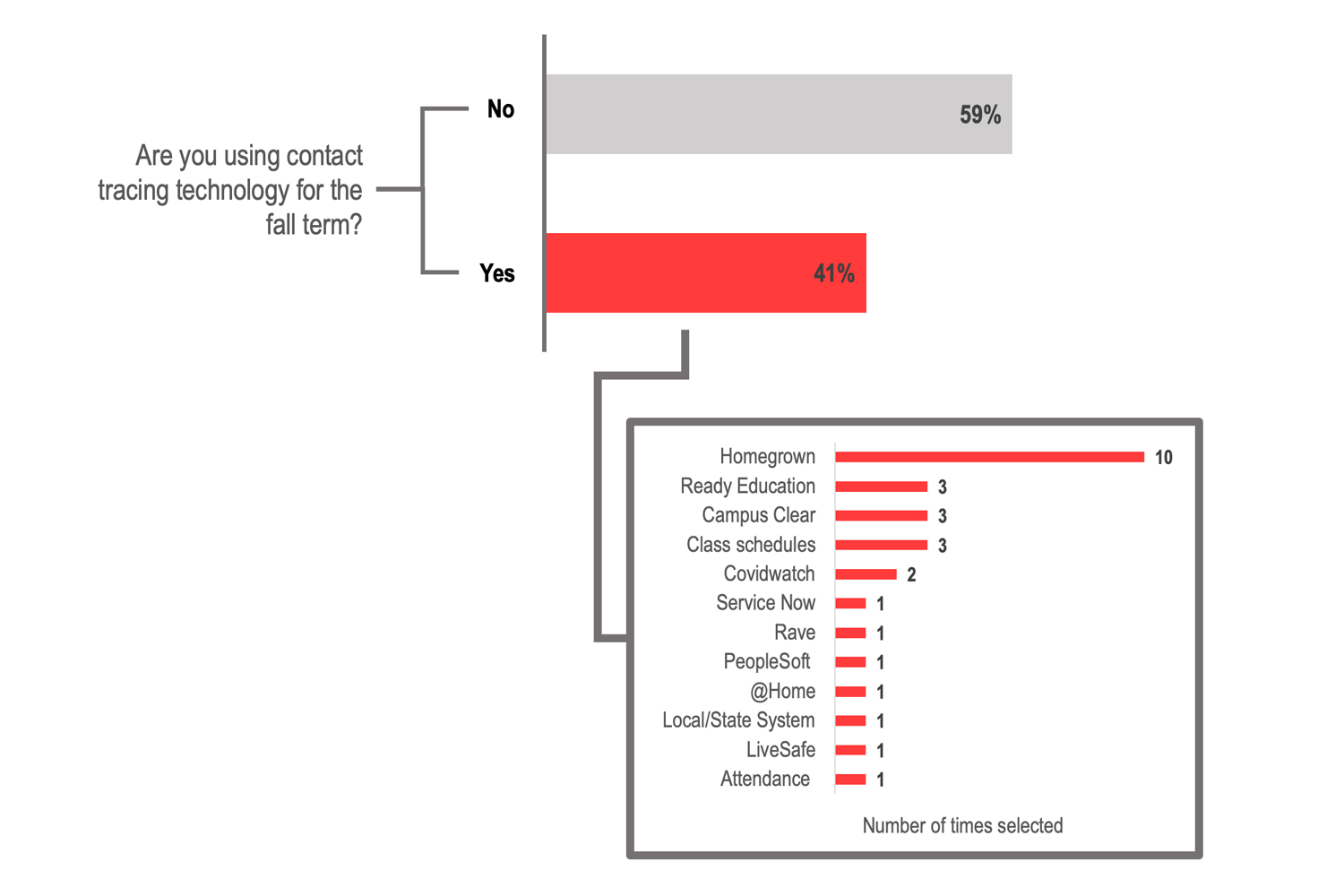
Contact tracing is more likely to be used among larger institutions. Importantly, though our limited QuickPoll sample constrains our ability to analyze and generalize findings by institutional characteristics, we do note evidence of a distinct and positive relationship between FTE size and institutional plans to deploy contact tracing technology, with nearly three-fifths of the largest institutions deploying contact tracing technology (see figure 4). We can offer several explanations for why this may be the case: (1) larger institutions will have more resources with which to secure and deploy these technologies; and/or (2) larger institutions may feel more compelled to put such solutions in place to help ensure the safety of the larger, and therefore potentially more at risk, communities they serve.
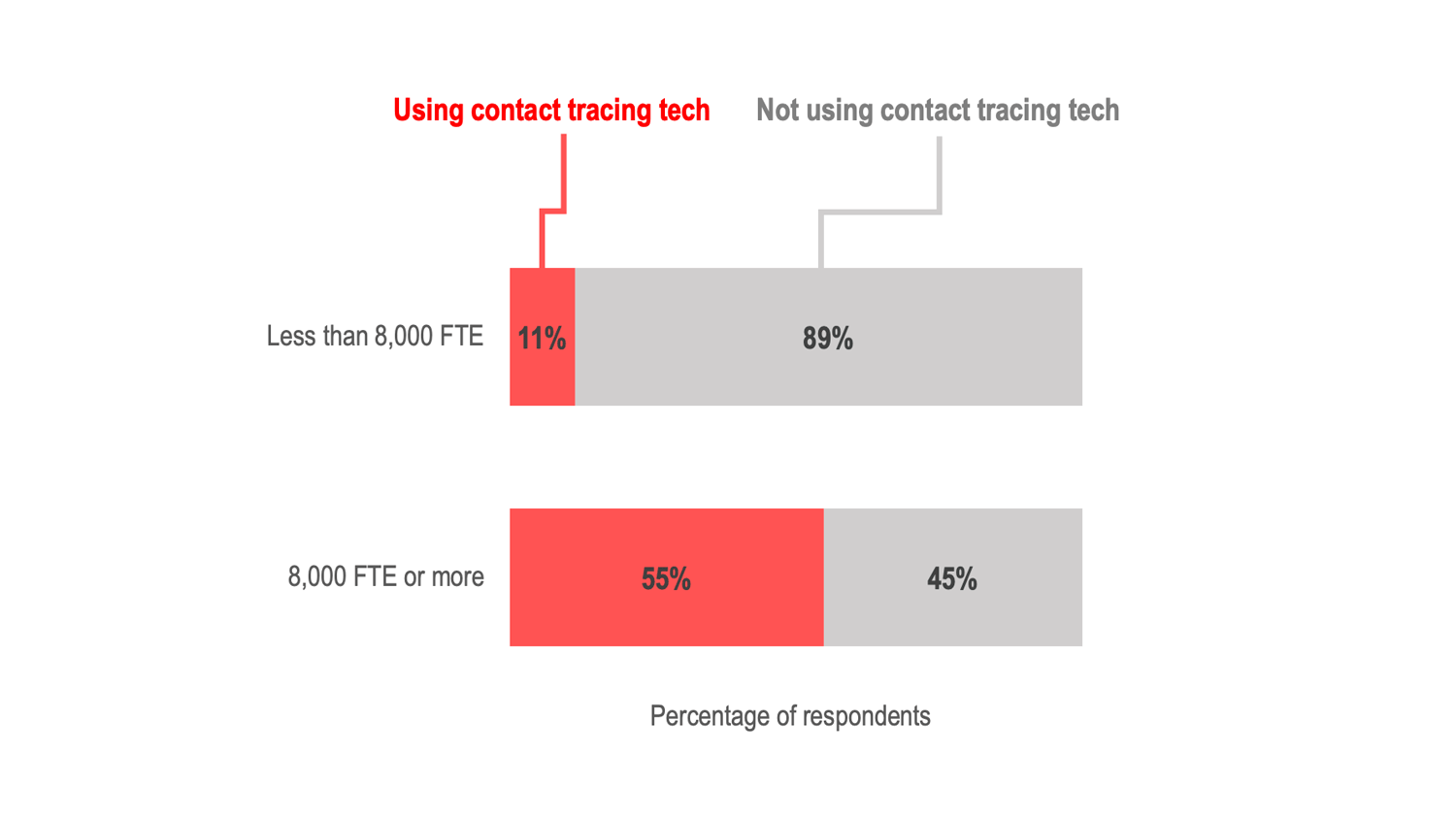
Contact tracing is for everyone, with or without consent. The use of solutions like contact tracing has not been without controversy in higher education; indeed, decisions that institutions make now around the widespread and long-term adoption of such solutions may have important implications for the privacy and security of student data into the future.7 For the vast majority of our respondents who reported the use of contact tracing, this solution will be used for "everyone" rather than just for students or just for staff and faculty. And among those reporting the use of contact tracing, strong majorities reported that contact tracing would be a requirement for all people entering the campus and that they would not be seeking individuals' consent before using the technology (see figure 5).
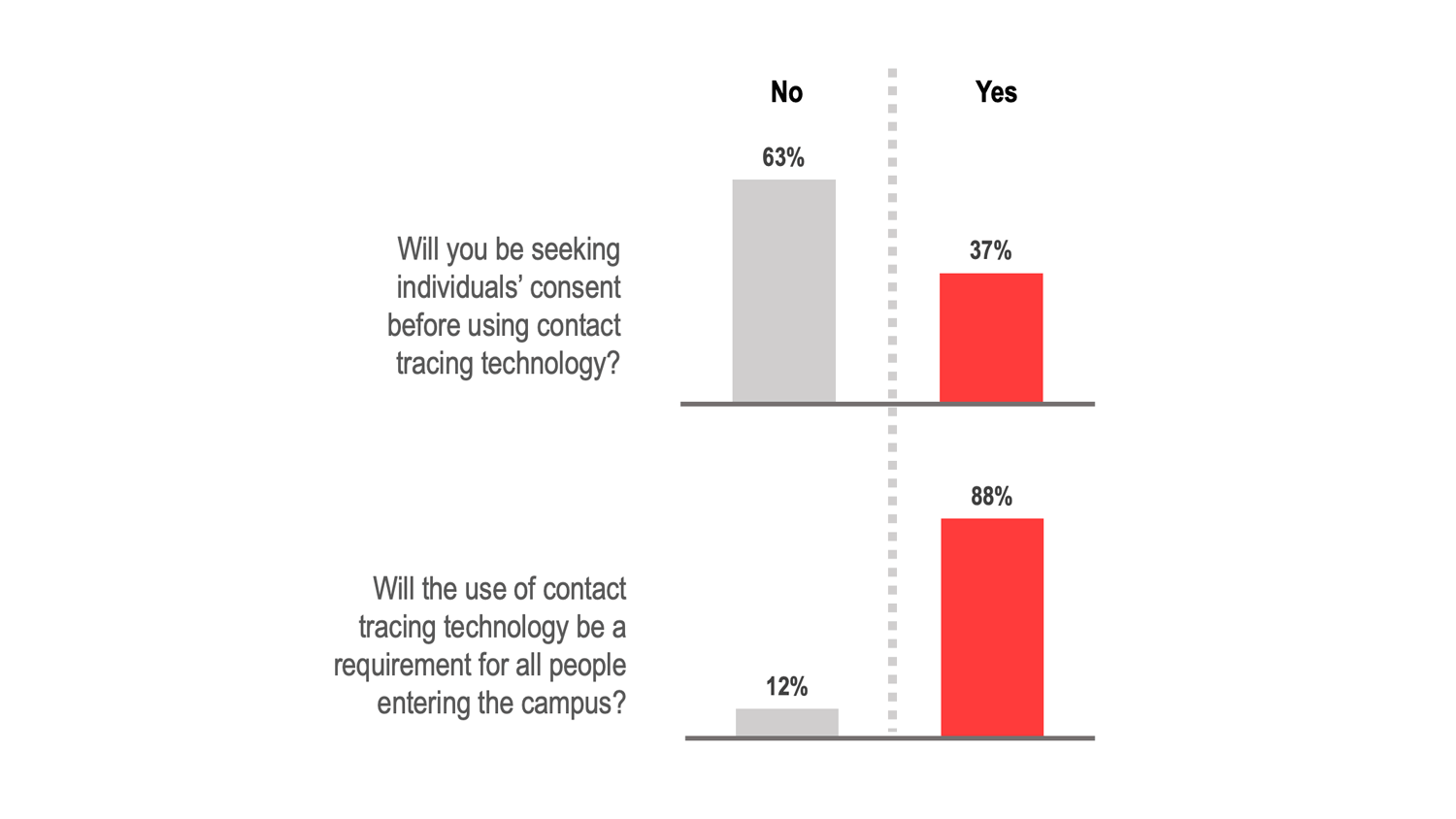
Community colleges are going "old school" for tracking. Finally, whether or not the institution will be using technology solutions for contact tracing, nearly two-thirds of respondents indicated they would at least be using some method of tracking for each individual entering a campus building as a part of the institution's contact tracing efforts (see figure 6). Of those methods respondents reported they would be using, the "sign-in sheet" was far and away the most commonly reported method, with all other methods (including more digital methods) lagging behind.
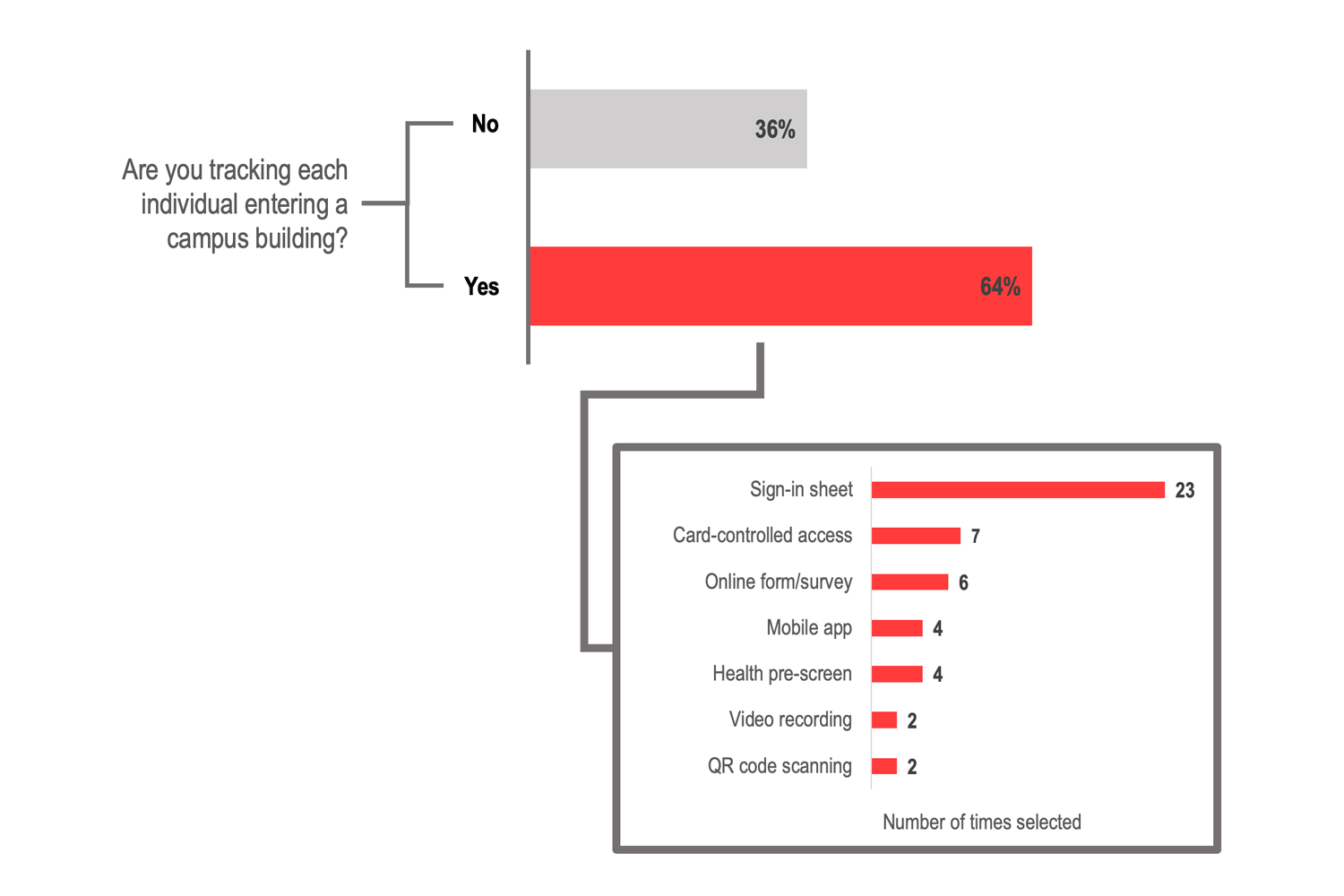
The Data: Health Screening on Campus
Institutions are going "manual" for health screening needs. Beyond the deployment of contact tracing technologies, institutions may have other options for monitoring and ensuring safety on campus, particularly through controlled access to certain spaces and/or screenings as people come and go from campus. When asked if they would be restricting building access only to those who needed to be in the buildings, a slight majority of respondents reported that they would not be doing so. Of those reporting that they would be restricting building access, the vast majority reported they would be using manual gatekeeping through the placement of staff either to check individuals' health system results or to ask screening questions (see figure 7).

Institutions run cold on checking temperatures. Temperature checks have been widely used for health screening across sectors and public spaces, including in higher education. Among our respondents, however, only 40% reported that they would be taking the temperature of students, faculty, and staff at the entrances of buildings on campus (see figure 8). This decision likely depends on the type of institution and the students they serve, since this rate increases to nearly 50% among respondents whose student population is 76–100% commuters. Among all institutions that will be taking temperatures, respondents were roughly evenly split between using handheld contactless meters and self-service methods.
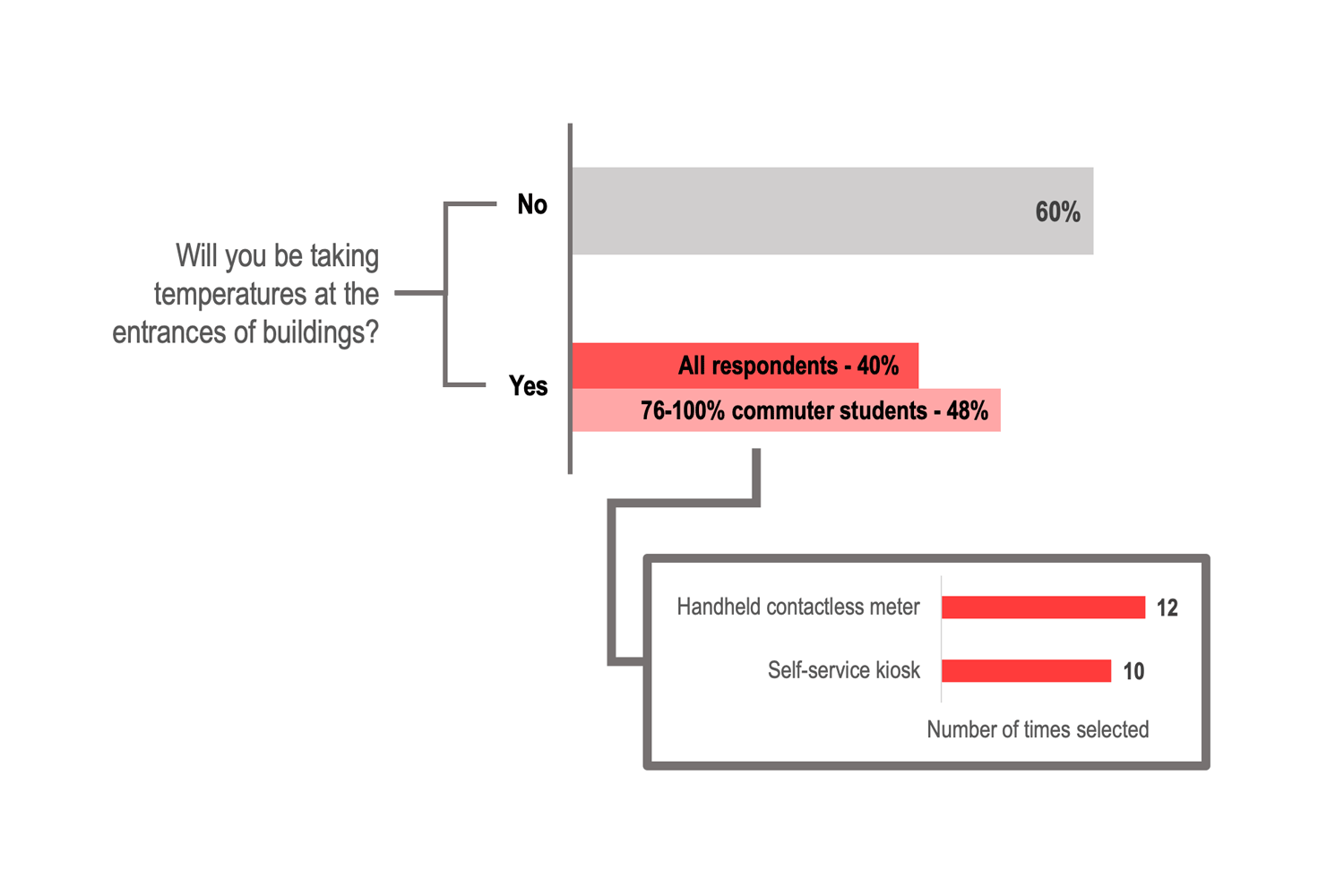
"Homegrown" solutions are also the choice for health screening—for those doing it. Finally, when asked if their institution is using a health screening product or service, a majority of respondents said they were not using such a product or service (see figure 9). Among those respondents who are using a health screening product or service, most reported using a "homegrown" solution for these purposes, while a handful of respondents reported using either Campus Clear or Ready Education.

Common Challenges
Moving from analog to digital. While our respondents provided evidence that they will be working to ensure the health and safety of their communities this fall, questions remain about the extent to which institutions will be leveraging technology resources to accomplish that work. Majorities of respondents reported not using contact tracing technologies or health screening products or services. In other areas, respondents noted the use of analog (e.g., sign-in sheets) and manual (e.g., staffed checkpoints) methods. Of course, many institutions, particularly those that are smaller and/or have fewer resources, may be limited in their options for securing and deploying technology solutions. And other institutions may still be working through cultures and systems unfamiliar with or resistant to new technologies and solutions—a challenge all too familiar to many institutions even under normal conditions.
Homegrown solutions are preferred. When institutions are deploying technologies, we find that those solutions are more likely to be homegrown than sourced through a solution provider. Some institutions may simply prefer homegrown solutions, since these solutions may fit better with particular institutional cultures, goals, or urgent needs. Other institutions, however, may find external solutions out of reach due to cost or limited support capacity. Whatever the reason, these findings appear consistent with what we know about community colleges and their adoption of homegrown solutions in general. In the EDUCAUSE 2019 Core Data Service survey we found that community colleges were adopting homegrown solutions in certain domains at a higher rate than other institutions. In particular, they appear more likely to adopt homegrown solutions in building- and facilities-related domains that would perhaps be germane to these institutions' COVID-19 safety planning and preparations (see table 1).
Table 1. 2019 Homegrown solutions in building and facilities domains
| System Area | % Homegrown All Institutions |
% Homegrown AA Institutions |
Difference between All and AA Institutions |
|---|---|---|---|
| Building Inventory | 18% | 33% | +16 |
| Parking | 20% | 36% | +16 |
| Performance Reviews | 37% | 47% | +11 |
| Building Project Management | 14% | 24% | +10 |
| Procurement | 5% | 14% | +9 |
| Event Management | 10% | 19% | +9 |
| Core Facilities Management | 8% | 15% | +7 |
Note: Differences between All and AA Institutions may appear incorrect due to rounding.
Source: EDUCAUSE Core Data Service survey, 2019
Promising Practices
Lean on the community. Whatever challenges institutions face through the COVID-19 pandemic, none need face them alone. Community colleges in search of resources and services for an uncertain future can find many of those supports among their peers and within the EDUCAUSE and larger higher education communities. Existing national and special-interest consortia can be sources of advice and standards for fall planning and preparations, and the EDUCAUSE Community Colleges Community Group can provide opportunities for direct sharing and learning among peers. Community colleges may serve as their own best resource for deploying technology solutions as well, offering one another opportunities for collective and collaborative bargaining and purchasing to ensure they get better access, as a group, to affordable solutions in the urgent short term and future.8
Explore creative dialogue with solution providers. Solution providers may be in a position to adapt practices and models to help institutions identify better and more affordable solutions, with a particular focus on those institutions with fewer options and more limited resources. Bret Ingerman, Vice President for Information Technology at Tallahassee Community College, offered a rather bold challenge to solution providers in his EDUCAUSE Review "Dear Vendors" letter:
There are institutions, such as community colleges, that have less means than do others to pay for your product. That doesn't make us less needy for the solution that you can provide or less able to effectively use it; it simply makes us less able to buy that solution. Perhaps your companies can intentionally price your products in a way that reflects the economic disparity existing within your potential client base.9
Whether or not solution providers can be quite as radically flexible as technology leaders like Ingerman might like, our shared crises in 2020 may be an opportunity for all of us, purchasers and providers alike, to approach our relationships in adaptively and creatively new ways.
Move toward digital transformation. Finally, in our previous EDUCAUSE QuickPoll surveys, technology leaders have reflected on the extent to which the COVID-19 pandemic may be accelerating digital transformation in higher education. Disruptions to "business as usual" may be prompting institutional leaders and faculty to embrace the benefits of technology in enabling improved processes, and technology leaders may finally find themselves in a position to initiate cross-institution strategic conversations and to partner with their colleagues to make positive and lasting changes. For those institutions seeking to digitally transform operations and better meet the needs of a post-pandemic world, assessing their readiness for transformation may help in starting now to move from short-term preparations for the fall toward long-term success and sustainability into the future.10
EDUCAUSE will continue to monitor higher education and technology related issues during the course of the COVID-19 pandemic. For additional resources, please visit the EDUCAUSE COVID-19 web page. All QuickPoll results can be found on the EDUCAUSE QuickPolls web page.
For more information and analysis about higher education IT research and data, please visit the EDUCAUSE Review Data Bytes blog, as well as the EDUCAUSE Center for Analysis and Research.
Notes
EDUCAUSE would like to thank its network of community college members for responding to this week's QuickPoll survey and making this article possible. In particular, we are grateful to Joe Mancini and John Stroud for their leadership in initiating this research, helping craft the survey questions, and reviewing the article.
- QuickPolls are less formal than EDUCAUSE survey research. They gather data in a single day instead of over several weeks, are distributed by EDUCAUSE staff to relevant EDUCAUSE Community Groups rather than via our enterprise survey infrastructure, and do not enable us to associate responses with specific institutions. ↩
- Dana C. Gierdowski, ECAR Study of Community College Students and Information Technology, 2019. research report (Louisville, CO: ECAR, May 2019). ↩
- Davis Jenkins and John Fink, "How Will COVID-19 Affect Community College Enrollment? Looking to the Great Recession for Clues," Mixed Methods (blog), Community College Research Center, April 30, 2020. ↩
- The poll was conducted on August 25, 2020, consisted of 26 questions, and resulted in 104 responses. Poll invitations were sent to participants in EDUCAUSE community groups focused on IT and community college leadership. Most respondents represented US institutions, with a handful of respondents representing Canadian institutions. Respondents from an appropriately diverse and well-balanced range of institution sizes and types (e.g., commuting students) participated. ↩
- See Mark McCormack, "EDUCAUSE QuickPoll Results: Fall Planning for Online and Physical Spaces," EDUCAUSE Review, August 7, 2020. ↩
- Susan Grajek, "EDUCAUSE COVID-19 QuickPoll Results: Early Technology Practices to Support Campus Health," EDUCAUSE Review, June 19, 2020. ↩
- Alexander C. Kafka, "Will the Pandemic Usher in an Era of Mass Surveillance in Higher Education?" Chronicle of Higher Education, April 14, 2020. ↩
- Keith Fowlkes, "In Enterprise Technology Operations, Sometimes It's Not What We Buy but How We Buy It," EDUCAUSE Review, July 3, 2017. ↩
- Bret Ingerman, "Dear Vendors," EDUCAUSE Review, July 2, 2018. ↩
- D. Christopher Brooks and Mark McCormack, Driving Digital Transformation in Higher Education, research report (Louisville, CO: ECAR, June 2020); Malcolm Brown, Betsy Reinitz, and Karen Wetzel, "Digital Transformation Signals: Is Your Institution on the Journey?" EDUCAUSE Review, May 12, 2020. ↩
Mark McCormack is Senior Director of Analytics and Research at EDUCAUSE.
© 2020 Mark McCormack. The text of this work is licensed under a Creative Commons BY-NC-ND 4.0 International License.
